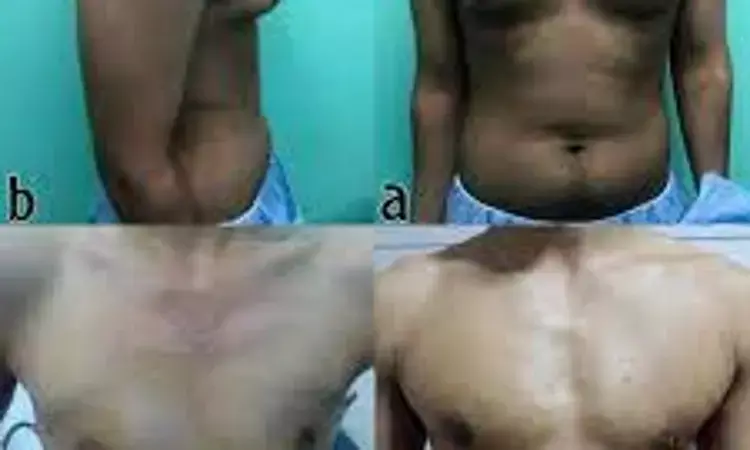- Home
- Medical news & Guidelines
- Anesthesiology
- Cardiology and CTVS
- Critical Care
- Dentistry
- Dermatology
- Diabetes and Endocrinology
- ENT
- Gastroenterology
- Medicine
- Nephrology
- Neurology
- Obstretics-Gynaecology
- Oncology
- Ophthalmology
- Orthopaedics
- Pediatrics-Neonatology
- Psychiatry
- Pulmonology
- Radiology
- Surgery
- Urology
- Laboratory Medicine
- Diet
- Nursing
- Paramedical
- Physiotherapy
- Health news
- Fact Check
- Bone Health Fact Check
- Brain Health Fact Check
- Cancer Related Fact Check
- Child Care Fact Check
- Dental and oral health fact check
- Diabetes and metabolic health fact check
- Diet and Nutrition Fact Check
- Eye and ENT Care Fact Check
- Fitness fact check
- Gut health fact check
- Heart health fact check
- Kidney health fact check
- Medical education fact check
- Men's health fact check
- Respiratory fact check
- Skin and hair care fact check
- Vaccine and Immunization fact check
- Women's health fact check
- AYUSH
- State News
- Andaman and Nicobar Islands
- Andhra Pradesh
- Arunachal Pradesh
- Assam
- Bihar
- Chandigarh
- Chattisgarh
- Dadra and Nagar Haveli
- Daman and Diu
- Delhi
- Goa
- Gujarat
- Haryana
- Himachal Pradesh
- Jammu & Kashmir
- Jharkhand
- Karnataka
- Kerala
- Ladakh
- Lakshadweep
- Madhya Pradesh
- Maharashtra
- Manipur
- Meghalaya
- Mizoram
- Nagaland
- Odisha
- Puducherry
- Punjab
- Rajasthan
- Sikkim
- Tamil Nadu
- Telangana
- Tripura
- Uttar Pradesh
- Uttrakhand
- West Bengal
- Medical Education
- Industry
Liposuction and port site nipple sparing mastectomy viable options for treating grade I to II gynecomastia

Gynecomastia is characterized by unusually large masses that radiate concentrically from the base of the nipple and is caused by abnormal growth of the glandular tissue of the male breast.
Liposuction and port site nipple-sparing mastectomy are viable options for treating grade I to II gynecomastia suggests a new study published in the BMC Surgery
Gynecomastia is characterized by unusually large masses that radiate concentrically from the base of the nipple and is caused by abnormal growth of the glandular tissue of the male breast. An alternative strategy for the surgical treatment of gynecomastia was used in this experimental study, which aims to use liposuction and port site nipple sparing mastectomy.
The study was conducted in the surgical oncology unit at Alexandria Main University Hospital included 103 patients with a mean age of 27 and no medical history. 100 patients had bilateral gynecomastia, and three patients had unilateral gynecomastia,with two having it on the right side and one on the left.
Results
Among the 103 participants, 83 had grade II gynecomastia and 20 had grade I. Only one of the three patients who participated in the study had an expanding hematoma on one side that needed to be surgically evacuated in the operating room. None of our patients experienced an infection or seroma following surgery. Furthermore, only three of our patients experienced nipple areolar complicated superficial epidermolysis, which need regular dressings until recovery. Of the 103 patients, 97 (94.17%) were pleased with the outcomes.
Liposuction and port site nipple sparing mastectomy are viable options for treating grade I to II gynecomastia, particularly if the patient prefers a more aesthetically pleasing chest contour; no scars equals better patient satisfaction.
Reference
Asal, M., Ewedah, M., Bassiony, M. et al. Liposuction and port site nipple sparing mastectomy: an alternative method for the operative treatment of gynecomastia at Alexandria main university hospital. BMC Surg 23, 244 (2023). https://doi.org/10.1186/s12893-023-02146-9
Keywords:
Liposuction, port site, nipple sparing, mastectomy, viable, options, treating grade, I to II gynecomastia,Asal, M., Ewedah, M., Bassiony, M.
Dr. Shravani Dali has completed her BDS from Pravara institute of medical sciences, loni. Following which she extensively worked in the healthcare sector for 2+ years. She has been actively involved in writing blogs in field of health and wellness. Currently she is pursuing her Masters of public health-health administration from Tata institute of social sciences. She can be contacted at editorial@medicaldialogues.in.
Dr Kamal Kant Kohli-MBBS, DTCD- a chest specialist with more than 30 years of practice and a flair for writing clinical articles, Dr Kamal Kant Kohli joined Medical Dialogues as a Chief Editor of Medical News. Besides writing articles, as an editor, he proofreads and verifies all the medical content published on Medical Dialogues including those coming from journals, studies,medical conferences,guidelines etc. Email: drkohli@medicaldialogues.in. Contact no. 011-43720751


